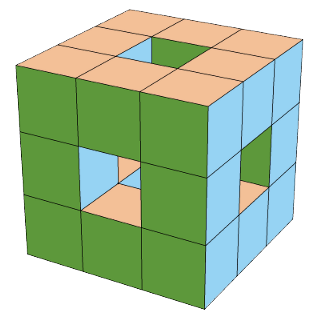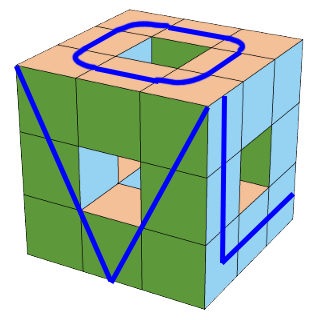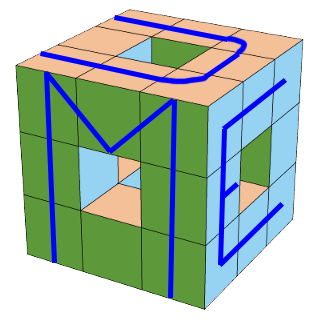| Home Register Puzzles Solve Teams Statistics Rules Solving Guide F.A.Q. Archive mezzacotta |
Solution: 2E. Hollow
It looks like we might need to cut out these pieces and assemble them into solid shapes. And that's exactly right! Four of them make cubes, and eight make rectangular prisms of the same size as two of the cubes stuck together. This comes to a total of 20 small cubes.
It makes sense to think that we might need to assemble the pieces in some way, into some three-dimensional shape. The blue lines on the cubes might then join up to make meaningful shapes. The thing to decide is what shape to make. A Rubik's cube-like arrangement of 3×3×3 small cubes contains 27 cubes, but we don't have that many. However, a little thought can come up with another symmetrical shape based on that line of thought. By removing the central cube of each face, plus the central cube of the entire 3D arrangement, we subtract 7 cubes, leaving 20. In other words, the pieces we have could potentially be used to build a shape like this:

Promisingly, this could conceivably be described as a "hollow cube", so the puzzle title serves as some confirmation. Working to keep the blue lines strictly on the outside of the large cube, and to connect them together into meaningful shapes, it's possible to construct the following:


The blue lines can be seen to form letters, which anagram to one appropriate word: VOLUME, the solution.
Puzzle design notes
I always like to include a 3D construction puzzle of some sort in our competitions. Some are harder than others. This one is relatively easy, as they come. It was quite a simple idea - simply construct a large cube and form letters on the faces. Removing the central cubes to make a hollow cube was done to provide something a bit more novel than just a full cube of 27 small cubes.
With the centre cube of each face missing, several letters were knocked out of the available alphabet: A, B, H, I, N, P, R, S, T, X, Y, Z. Fortunately this left three vowels. I wrote a program to search a dictionary for six letter words using only the remaining letters, and with no repeated letters, and ended up with a list of a few hundred. It was then a matter of reading through them to find one with a thematic meaning.
